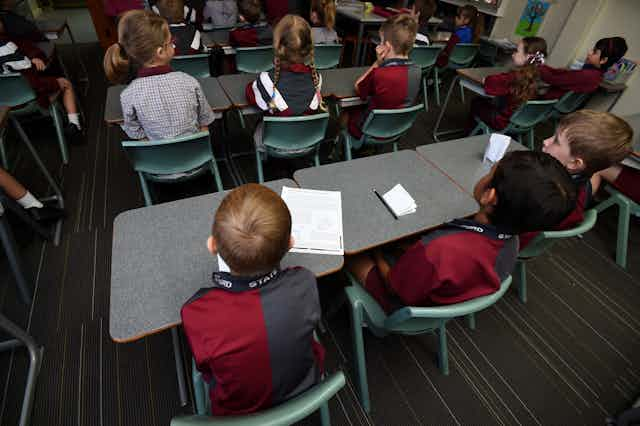The National Assessment Program – Literacy and Numeracy (NAPLAN) results released on Wednesday show Australian students are making few gains in literacy and numeracy. National average performance scores in grades 3, 5, 7, and 9 have barely shifted since the standardised tests began almost ten years ago.
But averages don’t tell the full story. Diving into the details is essential to understand what is going on in Australian education.
The average NAPLAN scores simply show a grade 3 child in 2016 is performing at roughly the same level in the specific domains of writing, reading and numeracy as grade 3 child in 2008.
Looking at student cohort gain over time tells a very different story. While average national NAPLAN scores may have remained stagnant in some individual subjects or year levels since 2008, there have been significant improvements in cohort scores overall as students moved through schooling. For instance, their scores for reading improved between grade 3, grade 5, year 7, and year 9.
There are also big differences between states. A majority of states have increased their average scores since 2008, but some have made huge strides.
Queensland’s education reforms and increased investments in preschool and early primary school, and stronger focus on how teachers teach, are showing up in 2016 scores that are substantially above their 2008 levels. It still trails Victoria, New South Wales and the ACT (in part due to socioeconomic and geographic factors), but it is improving at a much faster rate.
The average reading test score for Queensland students in grade 3 jumped from 371.1 to 437.7 between 2008 and 2016 compared to a national increase from 400.5 to 425.7. As for numeracy, the average score for Queensland grade 3s soared from 367.9 to 396.8 compared to a minor increase of just 396.6 to 402 nationally.
Incidentally, Queensland also received a 34% increase in federal funding between 2013 and 2016; the biggest percentage increase of any state.
But given how much money, time, and effort has been invested in schooling reforms, why aren’t we seeing substantial improvement in all jurisdictions? And why is a core group of children continuing to score below the national minimum standard, especially when this minimum is already set very low?
Why aren’t we seeing progress?
Whether funding makes a difference depends on where it goes and how it is spent.
In Australia, funding is not adequately targeted to the schools with the greatest education needs. Nor have additional funds been consistently spent on evidence-based programs that lift learning.
Poorly allocated funding is the foremost reason why student background (socioeconomic factors, indigeneity, and where a student lives) continues to have what the Gonski Review of School Funding described as:
… an unacceptable link between low levels of achievement and education disadvantage, particularly among students from low socioeconomic and Indigenous backgrounds.
Students from low-socioeconomic-status households are far less likely to meet year 7 milestones, complete year 12 or equivalent by age 19, or be engaged in full-time work, training or education at age 24. Australia’s school system is not meeting their needs as well as it could or should.
While the “Gonski” funding boost and needs-based formula introduced by the Labor government has made a difference, it has only been flowing for a few years. And, in some cases, it doesn’t fully compensate for the cessation of other federal funding from national partnership programs that channelled more money into high-need schools.
This national partnership money was instrumental in turning around schools such as Kambrya College in Victoria. Kambrya used its national partnership funding to strategically invest in several measures to transform it from one of the worst to best-performing schools in Victoria. Improvement takes focused effort over several years.
Finally, too many young Australians start school without a secure foundation to take advantage of the learning opportunities at school. One-third of kids miss out on the number of hours of preschool needed to make a difference. And an estimated 60,000 begin school developmentally vulnerable in one or more vital domains.
Current policy and funding arrangements mean children who would benefit the most from quality early education – those from more disadvantaged backgrounds – are also those most likely to miss out.
What can be done?
There is no single way to improve the education performance of Australian schooling. But evidence in Australia and internationally suggests a number of changes that could help.
Increasing public investment where the impact (and opportunity) is greatest. This means better targeting funding to those schools with greater education needs, and focusing funding on evidence-based programs that have been shown to lift learning, such as targeted teaching, meaningful and timely feedback to students and teachers, and school-leader capacity;
Expanding access to quality early education for all children as a legislated entitlement, supported by ongoing funding, so that all kids have a secure education foundation prior to schooling; and
Putting NAPLAN in perspective. The national standardised assessment only measures a few (albeit vitally important) skills in a small number of domains every two years. A blinkered focus on test preparation or test results at the exclusion of other skills and subject areas can actually weaken students’ learning and development.

